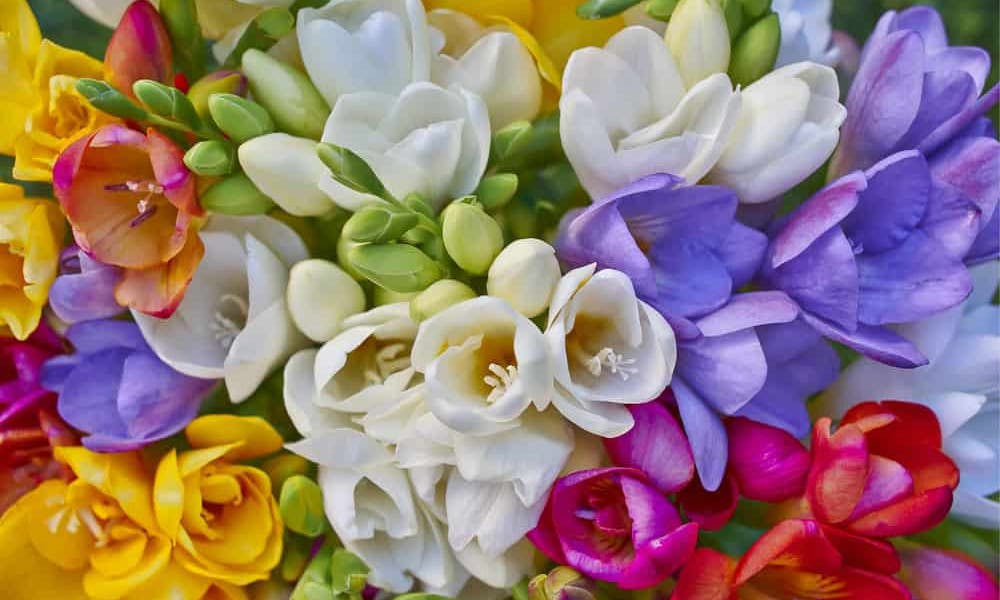MENU
The Freesia Flower Is Highly Decorative with a Charming Perfume, a Perfect Reason to Bring It at Home

If you are looking for inner peace, relaxation, and a mind free of stress, just look to nature’s beauties and wonders. Put a flower next to you, and look at it growing, showing its beautiful colors, perfuming the air around it, and standing fiercely and gracefully. Don’t you find this incredible? Don’t you feel relaxed and happy? Now, we guess you can understand why offering flowers is a great idea, regardless of the occasion.
In case you are looking for an excellent flower to grow in or out-doors, for its decorative attributes and sweet scent, you can choose today’s suggestion: the freesia flower.
With its trumpet-shaped flowers standing at the end of a floral spike, it can brighten the surroundings with its bright colors such as red, yellow, white, or purple, depending on the species. Moreover, freesia is particularly fragrant and composes many perfumes. Its name was in honor of a German doctor called “Freese.”
You can get to know more about this beautiful flower with these fantastic qualities, by following the next points:
* What Defines a Freesia Flower?
* Successfully Planting Your Freesia Flower
* Tips on Maintaining Your Freesia Flower
* Can Your Freesia Flower Be Sick?
What Defines a Freesia Flower?
Freesia belongs to the Iridaceae family. It is originally from South Africa and is the result of numerous hybridizations.
It is a bulbous perennial plant with a corm and deciduous leaves of beautiful tender green. The flowers bloom in small linear spikes, at the top of fine, arched stems.
Their corollas, well scented, with many colors (yellow, white, orange, red, pink, blue, lilac), are arranged in a funnel or bell shape and are between 3 and 5 cm long. Some varieties have less fragrant double flowers.
This plant likes dry winters with low frosts and hot summers with rain. Freesia is one of the 10 most fragrant flowers along with honeysuckle, gardenia, wisteria, hyacinth, jasmine, lavender, lilac, lily, and rose. Its fragrance, reminiscent of jasmine and orange blossom, is widely used in perfumery. The white or yellow varieties are the most fragrant.
Successfully Planting Your Freesia Flower
Freesia likes sandy, light, well-drained, not too rich, and fresh soils. It appreciates warm, sunny places, but you can also plant it in half-shade, and it is going to grow well. However, avoid imposing midday sun exposure, as it can be harmful. For a potted crop, choose a bright, airy, and cool spot.
The best period to plant your freesia in open ground is during April and May. If you wish to go for a potted plant, then the autumn period is better.
Here is how to plant it. First, prepare the planting area. Remove weeds, roots, and stones. Then, dig a flat hole about 3 cm to 5 cm deep and 5 cm wide. Add a bed of gravel, if your soil is heavy, to make drainage easier. Lay out the bulb, with the tip pointing upwards. Cover with a layer of soil and pack well around it. Finally, water without soaking the ground.
Tips on Maintaining Your Freesia Flower
To correctly maintain your freesia flower, water it moderately but regularly. This plant should not lack water at all. Intensify watering as soon as flower buds appear. Alternatively, decrease watering when the flowers are fading, then let them dry out completely.
Apply liquid fertilizer for bulbs or flowering plants every fortnight, as soon as the flower buds appear and as long as the leaves remain green.
If necessary, support the tall varieties with small wooden stems when the vegetation appears.
As freesia is not frost resistant, you should avoid at all costs by leaving it outside if you live in places with harsh winters. Bring your pots or dig up the bulbs in a protected area before the first frosts. In regions with a mild climate, you can leave your bulbs in the ground with a protective mulch and move your pots close to a wall for a little shelter.
Can Your Freesia Flower Be Sick?
From what we have seen before, you may think that this plant may require too much care. We are happy to tell you in advance that freesia is somewhat resistant. It has two main worries: frost and excess humidity that can be both very harmful for it.
However, like any living creature, it can suffer from certain diseases. You need to know about them to successfully diagnose them and provide the best treatment to your plant.
The first disease you should know is called “fusariosis.” It refers to dry leaves and roots and damaged cormus. To heal your plant, destroy affected bulbs. Clean the pots well before planting and add sterilized compost.
Another disease that can affect your plant is called the “grey rot.” It is described by greyish stains on leaves and flowers. To heal your plant, you should remove the affected parts.
Red spiders, aphids, snail, and slugs can also attack your freesia plant.
Flowers are perfect for bringing any touch of elegance, grace, and colors into your home. They are ideal tools for any decoration and can help you reconnect with nature and your inner peace. They also give a beautiful and welcoming look to your house to any visitor.
The flower we learned about today is freesia. It is very famous as an ornamental flower and one of the most used in perfumes, with its sweet scent that can remind you of jasmine or orange blossom.
Coming from South Africa, this perennial plant does not require too much care. In fact, you just need to keep it away from frost and excess humidity. Like any plant, it can get sick. Thus, you should know when to heal it. However, we can say that freesia is a resistant plant. After all, freesia flowers are worth every minute of your lovely care.

